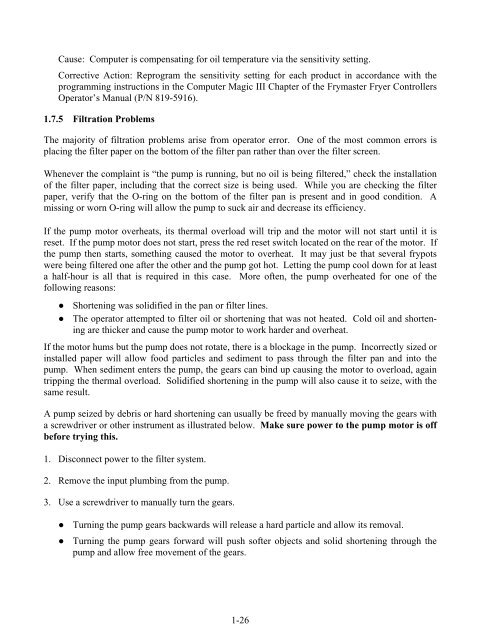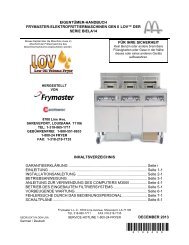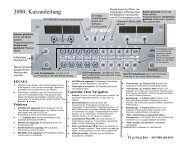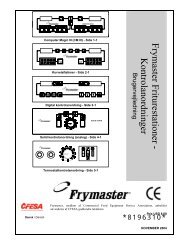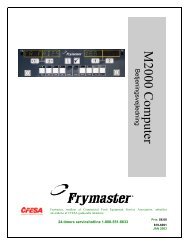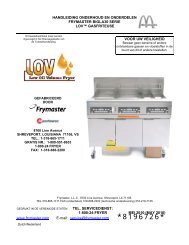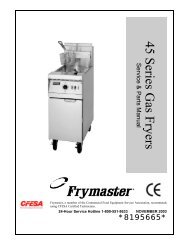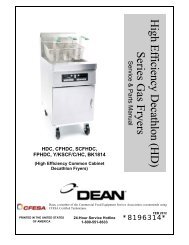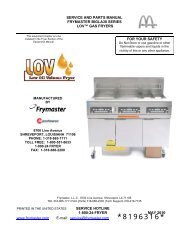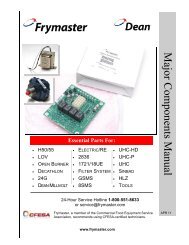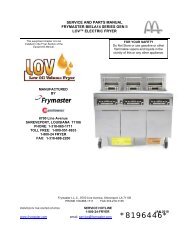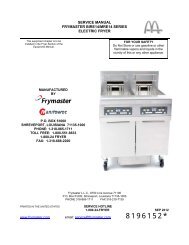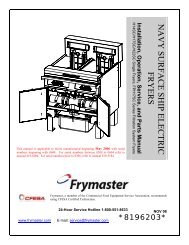819-0001 JUN 07.pdf - Frymaster
819-0001 JUN 07.pdf - Frymaster
819-0001 JUN 07.pdf - Frymaster
You also want an ePaper? Increase the reach of your titles
YUMPU automatically turns print PDFs into web optimized ePapers that Google loves.
Cause: Computer is compensating for oil temperature via the sensitivity setting.<br />
Corrective Action: Reprogram the sensitivity setting for each product in accordance with the<br />
programming instructions in the Computer Magic III Chapter of the <strong>Frymaster</strong> Fryer Controllers<br />
Operator’s Manual (P/N <strong>819</strong>-5916).<br />
1.7.5 Filtration Problems<br />
The majority of filtration problems arise from operator error. One of the most common errors is<br />
placing the filter paper on the bottom of the filter pan rather than over the filter screen.<br />
Whenever the complaint is “the pump is running, but no oil is being filtered,” check the installation<br />
of the filter paper, including that the correct size is being used. While you are checking the filter<br />
paper, verify that the O-ring on the bottom of the filter pan is present and in good condition. A<br />
missing or worn O-ring will allow the pump to suck air and decrease its efficiency.<br />
If the pump motor overheats, its thermal overload will trip and the motor will not start until it is<br />
reset. If the pump motor does not start, press the red reset switch located on the rear of the motor. If<br />
the pump then starts, something caused the motor to overheat. It may just be that several frypots<br />
were being filtered one after the other and the pump got hot. Letting the pump cool down for at least<br />
a half-hour is all that is required in this case. More often, the pump overheated for one of the<br />
following reasons:<br />
● Shortening was solidified in the pan or filter lines.<br />
● The operator attempted to filter oil or shortening that was not heated. Cold oil and shortening<br />
are thicker and cause the pump motor to work harder and overheat.<br />
If the motor hums but the pump does not rotate, there is a blockage in the pump. Incorrectly sized or<br />
installed paper will allow food particles and sediment to pass through the filter pan and into the<br />
pump. When sediment enters the pump, the gears can bind up causing the motor to overload, again<br />
tripping the thermal overload. Solidified shortening in the pump will also cause it to seize, with the<br />
same result.<br />
A pump seized by debris or hard shortening can usually be freed by manually moving the gears with<br />
a screwdriver or other instrument as illustrated below. Make sure power to the pump motor is off<br />
before trying this.<br />
1. Disconnect power to the filter system.<br />
2. Remove the input plumbing from the pump.<br />
3. Use a screwdriver to manually turn the gears.<br />
● Turning the pump gears backwards will release a hard particle and allow its removal.<br />
● Turning the pump gears forward will push softer objects and solid shortening through the<br />
pump and allow free movement of the gears.<br />
1-26


